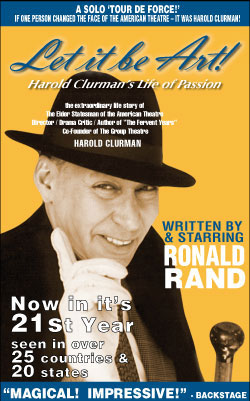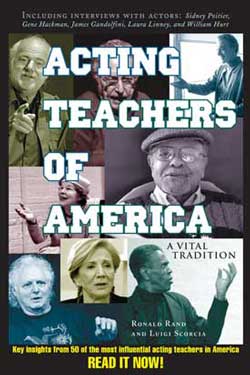Project HOOP
This article begins with a quote by Hanay Geiogamah, (Kiowa/Delaware), Director of Project HOOP: “Let me try to stimulate your imagination. There are 512 or so Indian tribes in the United States today. If each one were to establish and sponsor its own theater company, and produce just one new work based on its history, culture, and heritage, we would have 512 new works for the theater. And if only half of them were to do this – in some fantastical dream-come-true – then there would be 256 new Indian plays. The theater can help us in so many good ways. Theater is one of the most accessible of the performing arts, and we should begin immediately to create new Indian theaters.”
Founders and co-directors of Project HOOP, Hanay Geiogamah, Professor of Theater in the UCLA School of Theater, Film, and Television; and Jaye T. Darby, Ph.D., a leading theater educator and Assistant Professor in the College of Education at San Diego State University created Project HOOP as a national multi-disciplinary initiative to advance Native theater artistically, academically, and professionally.
Project HOOP, originally funded by the W.K. Kellogg Foundation, is currently funded by the U.S. Department of Education’s Fund for the Improvement of Postsecondary Education (FIPSE), and seeks to establish and develop academic and artistic programs in the field of Native theater.
The purpose and overarching goal of Project Hoop is to establish Native theater as an integrated subject of study and creative development in tribal colleges, Native communities, K-12 schools, and mainstream institutions, based on Native perspectives, traditions, views of spirituality, histories, cultures, languages, communities, and lands.
Of all the twentieth-century Native art forms rooted in tribal traditions, Native theater remains the most neglected due to lack of funding, scholarship, curriculum development, and staffing. Yet Native theater is perhaps one of the most viable for tribal communities and educational settings because of its high interest level for students, its high degree of grassroots community involvement, the versatility for unique tribal expression and cultural generation, and the potential for economic development.
Through the advancement of Native theater programs, Project HOOP looks to the development of powerful cultural, spiritual, and economic pipelines throughout interested tribal colleges and communities and opportunities for Native students and community members to assume leadership roles in community, regional, and national theater, film, and television.
Project HOOP simultaneously combines academic and artistic program delivery in Native theater with community cultural development and economic empowerment for tribal colleges, schools, and their communities. Specifically, the initiative first developed and implemented a replicable two-year program that included core curriculum, scholarly books, mentoring expertise, and a community theater festival at Sinte Gleska University in Rosebud, South Dakota.
Successful refinements of this pilot led to a multi-model design to increase flexibility and tribal community involvement in the implementation of the project in a variety of settings, including the Institute of American Indian Arts in Santa Fe, New Mexico, Haskell Indian Nations University in Lawrence, Kansas, Little Big Horn College in Crow Agency, Montana, and other interested sites. This multi-model design encompasses ten educational models to enhance delivery of academic and artistic offerings and support the development of Native performing arts.
At the Project HOOP Website, you will find the following brief profiles of seven of the 14 Native American theatre companies, projects, and support organizations represented at the 3rd annual national Native performing arts conference held in Los Angeles in December, 2004. The profiles are based on verbal presentations by each project’s spokesperson and have been edited by the presenters and the HOOP website.
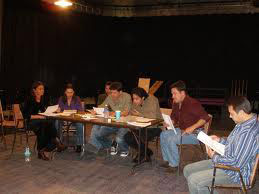 American Indian Community House, New York, New York
American Indian Community House, New York, New York
Dawn Gingold, Presenter; e-mail: dawngj@yahoo.com
Located in New York City, the American Indian Community House (AICH) is a 36 year-old organization serving one of the largest urban Native populations in the United States. In addition to being a social service agency with job training and health programs, it provides an Art Gallery and a Theater.
The theater department serves as a resource for Native performers and those looking to cast them. AICH keeps a database of Native performers – actors, singers, dancers, musicians, comics, and performance artists. AMERINDA (American Indians in the Arts), another Native organization in New York City, also keeps an. The Non-Traditional Casting Project in NYC is a third source for Native actors.
AICH hosts an annual month of performances called the Indian Summer series. This program, as well as an annual showcase for agents is funded by the New York State Council on the Arts. In addition, from time to time Native performers are booked into the Circle Theater and Art Gallery. Stories are told, poems, plays and screenplays are read, and workshops are given in acting, voice-overs, and commercials.
In collaboration with the Times Square Playwrights, AICH hosts the Second Sunday series, bringing a new developing play or screenplay to the Circle for a full-length reading each month. This program is the result of a community member volunteering. Other collaborations have been with City Lore for language development with the New York City American Indian community, as well as other ethnic theater groups. AICH has also worked with ABC on its Diversity Showcase.
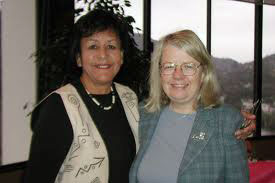 Haskell Indian Nations University, Thunderbird Theatre, Lawrence, Kansas
Haskell Indian Nations University, Thunderbird Theatre, Lawrence, Kansas
Pat Melody, Presenter; e-mail: Dyreyner@aol.com
The Thunderbird Theatre Program at Haskell Indian Nations University began in 1974 under the direction of Pat Melody. This theater is a inter-tribal, student-run organization, completely supported by student productions, and raises $10,000-$20,000 per year to fund productions. Haskell also offers an Associate of Arts degree with an emphasis in theater. Haskell’s theater program offers a full range of courses from an elective in Introduction to Theater, to Acting, Improvisation, American Indian Drama, Dramatization of Native Literature, to Theater History, and Performance. The members of the theater department are also developing a bachelor's degree for accreditation.
Since 1980, the Thunderbird Theatre has been touring throughout America, performing student-produced performances. These productions combine traditional and modern dance, acting, pantomime, and singing. The theater has also produced original works, including Kiowa writer N. Scott Momaday’s “Children of the Sun,” and Onieda playwright Bruce King’s “Threads: Ethel Nickle’s Little Acre” at the Lied Center of Kansas. When they are traveling, Thunderbird Theatre also provides community workshops.
Thunderbird Theatre presented the Will Sampson First Americans in the Arts award for outstanding contributions to Native American theater. The company was also recognized by the Kennedy Center American College Theater Festival for its production of “Weaving the Rain,” an original Native play by Kiowa playwright Dianne Yeahquo Reyner at the Lawrence Arts Center in conjunction with the University of Kansas English Alternative Theater (EAT).
Haskell Indian Nations University has been affiliated with Project HOOP for the last three years. During this time Project HOOP subcontracted the theater department to host three Project HOOP Summer Sessions as part of a major FIPSE grant under the supervision of Pat Melody, Director of Theater. During each session, students from a range of tribal colleges participated in an intensive five-week summer program, which included: Improvisation for the Theater, Introduction to American Indian Theater Performance, and Performance in Theater Arts. At the end of this intensive workshop the participants produced their own original work and performed in the Lawrence and Haskell communities, continuing to build bridges between local Native and non-Native communities.
Students have also had opportunities to work with noted artists-in-residence: Jane Lind, Aleut actress and director; Bruce King, Oneida playwright and director; Marcie Rendon, White Earth Anishinabe playwright; Dianne Yeahquo Reyner, Kiowa playwright, and Paul Stephen Lim, playwriting professor at the University of Kansas.
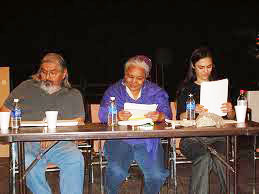 Institute of American Indian Arts, Santa Fe, New Mexico
Institute of American Indian Arts, Santa Fe, New Mexico
Terry Gomez, Presenter; e-mail: tgomez@iaiancad.org
The Institute of American Indian Arts (IAIA) was founded in 1962. The Project HOOP program officially began at IAIA in May of 2003. IAIA’s participating administrators are President Della Warrior and Dean Maxx Stevens in the Center for Arts & Cultural Studies. Terry Gomez is the Project HOOP Coordinator, as well as the instructor for the Acting I/II class and Dramatic Writing I class.
As part of their programming for Project HOOP, several professional actors presented workshops for the Acting I/II classes. In 2005, Jane Lind was in residence, and directed a show in which the students performed, entitled “Bits of Life” with scenes from Hanay Geiogamah’s “49,” Euripides’ “Medea,” “Taming of the Shrew,” Terry Gomez’s “Inter-Tribal,” and original monologues by students. Ms. Lind also worked with students in Dramatic Writing I classes.
Two other visiting artists worked with AIAI students. Scott Harrison, who directed “Fool for Love” by Sam Shepard at a local theater, gave a workshop and worked with IAIA students on scenes from that play. Dr. Luke Dixon, Artistic Director for the International Play Festival, London, gave a three-day workshop on personal stories and creation stories from around the world.
IAIA students presented a number of successful productions, including “Dirt Roads” and “Half-Wise.” In 2004, IAIA theater students put on Annette Arkeketa’s “Ghost Dance,” directed by Terry Gomez. This play, which investigates issues of repatriation, and was followed by a community panel discussion with distinguished repatriation activists including Ms. Arkeketa, Otoe-Missouri/Muscogee; Suzan Shown Harjo, Cheyenne/Muscogee; and Jimmy Arterberry, Comanche.
The IAIA theater program has become a known presence in Santa Fe and surrounding communities and has made connections with the University of New Mexico, local theaters, directors, and actors. More students have become involved with theater and performing arts at IAIA. IAIA also hosted the American Indian Higher Education Consortium (AIHEC) in 2005 in Albuquerque. Wes Studi and Michael Horse were the judges. Wes Studi, Michael Horse and Alan Arkin also worked with the students here during the semester.
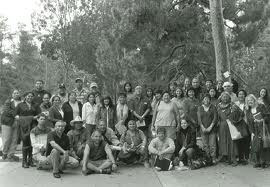 Red Earth Performing Arts, Seattle, Washington
Red Earth Performing Arts, Seattle, Washington
Frieda Kirk, Presenter; e-mail: kirkfl@earthlink.net
Red Earth Performing Arts, established in 1974, is one of the first Native American theater groups. The company disbanded in the late 1980’s. After the company was disbanded, in late 2003 Red Earth began the process of re-establishing the organization. Currently, Red Earth recently completed developing a board of directors to guide the course of the organization.
Red Earth has long focused on community-outreach through theater. The organization toured, and gave performances in Native communities. While on tour, they provided community workshops. In addition, Red Earth worked with school districts, holding class workshops with a performance at the end. Red Earth also conducted teacher education workshops that specialized in curriculum development, for example, by using local legends as a tool to teach geography, astronomy.
The new Red Earth aims to develop a professional theater, and to collaborate with universities to provide technical training and workshops.
Red Eagle Soaring, Spokane, Seattle, Washington
Martha Brice, Presenter; e-mail :resoaring@earthlink.net
Red Eagle Soaring Native American Theater Group (RES), founded in 1990 in Seattle Washington by a group of Native theater artists, is a tribute to Nez Perce theater artist John Kauffman.
RES has presented a variety of work over the years, including touring productions of plays for youth; a number of variety shows, “Celebrations of the First People,” and a dramatization of contemporary Native poetry entitled, “Cedars.” In addition, RES acts as an informal talent referral service for Native actors and other performance artists and groups.
From the beginning, however, Red Eagle Soaring’s highest priority was to serve the Native youth of their local urban community in the greater Seattle area, and in recent years they have become almost exclusively a Youth Theater group. In this urban multicultural setting, their youth participants, teaching artists, volunteers and staff represent tribes from all of North America. They have worked with a total of about 40 young people, ages 11 -19, over the course of a year. Each year they offer drama workshops and at least three opportunities for youth to perform their work, with one annual touring production.
In the summer, RES conducts an all-day two-week intensive drama workshop for beginners and advanced students together, culminating in a performance for the public. In the fall, RES runs two 12-week series of weekly acting workshops, one in beginning acting and storytelling and one advanced scene study class. In the spring, RES does a major production, with students chosen by audition. The play is usually written by the students and their teaching artists, and is often based on a traditional Native story. In early summer the play tours to reservation communities in Washington State and beyond as well as to schools, special tribal and cultural events, and colleges.
They are committed to teaching their youth Native tradition, given the diversity of tribes and bands and their ancestry. They hold hand drum-making and painting-drum workshops.
90% of their students report improvement (measured by end-of-project questionnaires) not only in drama skills, but in self-confidence, motivation, pride in self, interest in school, and a positive outlook on the future.
Their goals include touring with plays to other parts of the country, making a manual for their culturally-based teaching methods, and expanding their programs. They are seeking more funding, more administrative help, and most important, more Native actors, artists, performers, and teachers as they work to benefit their most precious natural resource – Native youth.
Sinte Gleska University and Project HOOP, Rosebud, South Dakota
Jeff Kellogg, Presenter; e-mail: jkellogg@sinte.edu
The Sinte Gleska University Native theater program is the first Project HOOP sponsored program held in Indian Country. Since its inception in 1997 at Sinte Gleska University as part of the W.K. Kellogg Foundations’s “Capturing the Dream,” Native American Higher Education Initiative, this program has grown to offer ten theater classes for 30 credit hours.
The Rosebud Theater produced two major community-based projects – “Woniya: Breath of the World,” developed and presented on the Rosebud Reservation; and “Wakinyan Agle na Ohakab Wiconi”/”After the Storm: Breath of Life,” developed and performed at Oglala Tribal College on the Pine Ridge Reservation.
The Rosebud Theater continues working on increasing pedagogy and building a Native American acting method based on the seven sacred directions. Mr. Kellogg holds classes in creative drama for the theater, an arts management class..
They have performed six productions, five of which were written outside the community. A production was written by an elder, a grandmother, and another woman. The Rosebud Theater also collaborates with the dance group to create dance/drama. This has been an exciting project, as this collaboration includes revitalizing a dance that has not been performed for years.
Tulsa Indian Actor's Workshop (TIAW), Tulsa,
Oklahoma Julie Little Thunder, Janna Rhoads, and JR Mathews, Presenters e-mail: jalit33549@aol.com, jrhoads@bixbyps.org, j_r_mathews@hotmail.com
Tulsa Indian Actor’s Workshop (TIAW), is over ten years old, and among their founders are Julie Little Thunder and Janna Rhoads, takes place in a multi-tribal urban setting, and has its roots in the American Indian Theater of Oklahoma. They moved their presentations to the performing arts center in Tulsa. Over the last 10 years, TIAW has been involved with community theater and arts festivals, collaborating with many different kinds of people, including Native artists. When writing or performing plays, the TIAW consults Native community elders on protocol and language. They also have a long-standing guest artist program and have won awards for set design and acting in regional community theater competitions.























